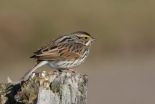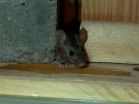(Press-News.org) Scientists of the CDF collaboration at the Department of Energy's Fermi National Accelerator Laboratory announced the observation of a new particle, the neutral Xi-sub-b. This particle contains three quarks: a strange quark, an up quark and a bottom quark (s-u-b). While its existence was predicted by the Standard Model, the observation of the neutral Xi-sub-b is significant because it strengthens our understanding of how quarks form matter. Fermilab physicist Pat Lukens, a member of the CDF collaboration, presented the discovery at Fermilab on Wednesday, July 20.
The neutral Xi-sub-b is the latest entry in the periodic table of baryons. Baryons are particles formed of three quarks, the most common examples being the proton (two up quarks and a down quark) and the neutron (two down quarks and an up quark). The neutral Xi-sub-b belongs to the family of bottom baryons, which are about six times heavier than the proton and neutron because they all contain a heavy bottom quark. The particles are produced only in high-energy collisions, and are rare and very difficult to observe.
Although Fermilab's Tevatron particle collider is not a dedicated bottom quark factory, sophisticated particle detectors and trillions of proton-antiproton collisions have made it a haven for discovering and studying almost all of the known bottom baryons. Experiments at the Tevatron discovered the Sigma-sub-b baryons in 2006, observed the Xi-b-minus baryon in 2007, and found the Omega-sub-b in 2009. The lightest bottom baryon, the Lambda-sub-b, was discovered at CERN. Measuring the properties of all these particles allows scientists to test and improve models of how quarks interact at close distances via the strong nuclear force, as explained by the theory of quantum chromodynamics (QCD). Scientists at Fermilab and other DOE national laboratories use powerful computers to simulate quark interactions and understand the properties of particles comprised of quarks.
Once produced, the neutral Xi-sub-b travels a fraction of a millimeter before it decays into lighter particles. These particles then decay again into even lighter particles. Physicists rely on the details of this series of decays to identify the initial particle. The complex decay pattern of the neutral Xi-sub-b has made the observation of this particle significantly more challenging than that of its charged sibling. Combing through almost 500 trillion proton-antiproton collisions produced by Fermilab's Tevatron particle collider, the CDF collaboration isolated 25 examples in which the particles emerging from a collision revealed the distinctive signature of the neutral Xi-sub-b. The analysis established the discovery at a level of 7 sigma. Scientists consider 5 sigma the threshold for discoveries.
CDF also re-observed the already known charged version of the neutral Xi-sub-b in a never before observed decay, which served as an independent cross-check of the analysis. The newly analyzed data samples offer possibilities for further discoveries.
The CDF collaboration submitted a paper that summarizes the details of its Xi-sub-b discovery to the journal Physical Review Letters. It will be available on the arXiv preprint server on July 20, 2011.
INFORMATION:
CDF is an international experiment of about 500 physicists from 58 institutions in 15 countries. It is supported by the U.S. Department of Energy, the National Science Foundation and a number of international funding agencies.
Fermilab is a national laboratory funded by the Office of Science of the U.S. Department of Energy, operated under contract by Fermi Research Alliance, LLC.
Fermilab experiment discovers a heavy relative of the neutron
2011-07-22
ELSE PRESS RELEASES FROM THIS DATE:
GOES satellite sees a triple header in the tropics
2011-07-22
The GOES-13 satellite captured a triple-header in the tropics today when it captured three tropical cyclones in one image in the Northern Hemisphere.
A visible image taken from the GOES-13 satellite on July 20 at 14:45 UTC (10:45 a.m. EDT) and shows a consolidating low pressure area called System 99L in the eastern North Atlantic Ocean, Tropical Storm Bret several hundred miles east of South Carolina, and a large Hurricane Dora off the west coast of Mexico. The image was created by the NASA/NOAA GOES Project at NASA's Goddard Space Flight Center in Greenbelt, Md.
System ...
It's no sweat for salt marsh sparrows to beat the heat if they have a larger bill
2011-07-22
Birds use their bills largely to forage and eat, and these behaviors strongly influence the shape and size of a bird's bill. But the bill can play an important role in regulating the bird's body temperature by acting as a radiator for excess heat. A team of scientists have found that because of this, high summer temperatures have been a strong influence in determining bill size in some birds, particularly species of sparrows that favor salt marshes. The team's findings are published in the scientific journal Ecography, July 20.
Scientists at the Smithsonian Migratory ...
Unlisted ingredients in teas and herbal brews revealed in DNA tests by high school students
2011-07-22
Take a second look at your iced or steaming tea. Guided by scientific experts, three New York City high school students using tabletop DNA technologies found several herbal brews and a few brands of tea contain ingredients unlisted on the manufacturers' package.
The teen sleuths also demonstrated new-to-science genetic variation between broad-leaf teas from exported from India versus small-leaf teas exported from China.
Guided by DNA "barcoding" experts at The Rockefeller University, an ethno-botanist at Tufts University and a molecular botany expert at The New York ...
UCSF study highlights success of brain surgery for severe epilepsy
2011-07-22
Two-thirds of people with severe and otherwise untreatable epilepsy were completely cured of their frequent seizures after undergoing neurosurgery at the University of California, San Francisco Medical Center, according to a new study that examined 143 of these patients two years after their operations.
The new study not only shows the promise of this type of neurosurgery at treating severe epilepsy, it also highlights how research into brain imaging may help to further improve results for people who have such operations.
"Surgery can be a powerful way to stop this ...
Whole sequence variation map reveals insight into evolutionary studies of rhesus macaque
2011-07-22
July 20, 2011 – BGI (previously known as the Beijing Genomics Institute), the largest genomics organization in the world, and Kunming Institute of Zoology, Chinese Academy of Sciences, together published the whole sequence variation map of rhesus macaque (Macaca mulatta) in Genome Biology on July 6th, 2011 (http://genomebiology.com/2011/12/7/R63). The study provides available resources for evolutionary and biomedical research.
Rhesus macaque, also called the Rhesus monkey, is one of the best known species of old world monkeys. Human and Rhesus macaque share a most recent ...
Cedars-Sinai movement disorders expert on international task force for dystonia treatment
2011-07-22
LOS ANGELES (July 20, 2011) –Neurologist Michele Tagliati, MD, director of the Movement Disorders Program at Cedars-Sinai Medical Center, served on an elite international task force commissioned by the Movement Disorder Society to provide insights and guidance on deep brain stimulation for dystonia, an uncommon condition that causes sustained, sometimes crippling muscle contractions.
The resulting articles, describing the data reviewed and outlining the group's conclusions, recommendations and points to be addressed in future research, published online last month in ...
Computer simulations aid understanding of bacterial resistance against commonly used antibiotics
2011-07-22
A recent study into the interactions between aminoglycoside antibiotics and their target site in bacteria used computer simulations to elucidate this mechanism and thereby suggest drug modifications.
In the article, which will be published on July 21st in the open-access journal PLoS Computational Biology, researchers from University of Warsaw, Poland, and University of California San Diego, USA, describe their study of the physical basis of one bacterial resistance mechanism - mutations of the antibiotic target site, namely RNA of the bacterial ribosome. They performed ...
Chromosome number changes in yeast
2011-07-22
Researchers from Trinity College Dublin have uncovered the evolutionary mechanisms that have caused increases or decreases in the numbers of chromosomes in a group of yeast species during the last 100-150 million years. The study, to be published on July 21st in the open-access journal PLoS Genetics, offers an unprecedented view of chromosome complement (chromosome number) changes in a large group of related species.
A few specific cases of chromosome number changes have been studied in plants and animals, for example the fusion of two great ape chromosomes that gave ...
'Freaky mouse' defeats common poison
2011-07-22
HOUSTON -- (July 21, 2011) -- Over millennia, mice have thrived despite humanity's efforts to keep them at bay. A Rice University scientist argues some mice have found two ways to achieve a single goal -- resistance to common poison.
New research by Michael Kohn and colleagues, reported today in the online journal Current Biology, analyzes a genetic mutation that has given the ordinary European house mouse this extraordinary ability.
The gene in question, vkorc1, is present in all mammals and manages vitamin K. A mutation to vkorc1 makes mice resistant to warfarin, ...
Skin sentry cells promote distinct immune responses
2011-07-22
A new study reveals that just as different soldiers in the field have different jobs, subsets of a type of immune cell that polices the barriers of the body can promote unique and opposite immune responses against the same type of infection. The research, published online on July 21st by Cell Press in the journal Immunity, enhances our understanding of the early stages of the immune response and may have important implications for vaccinations and treatment of autoimmune diseases.
Dendritic cells serve as sentries of the immune system and are stationed at the body's ...




